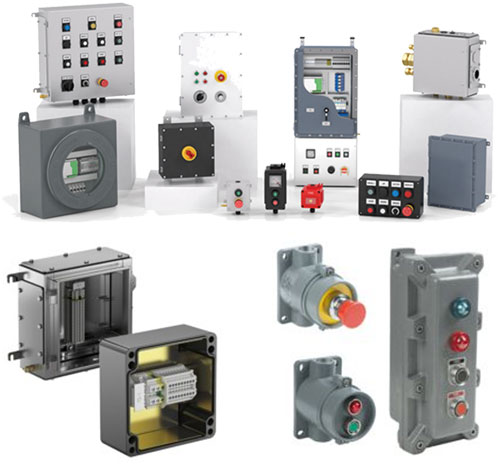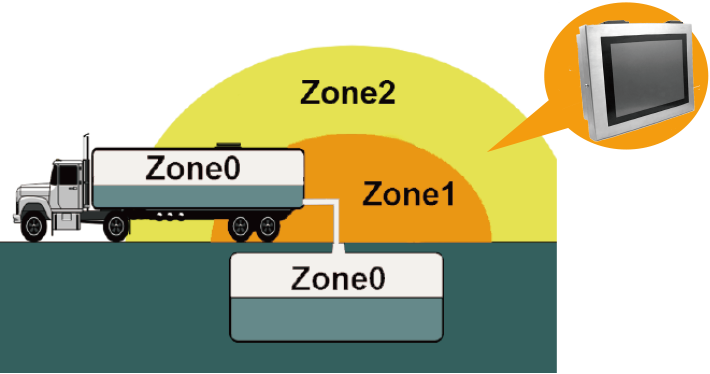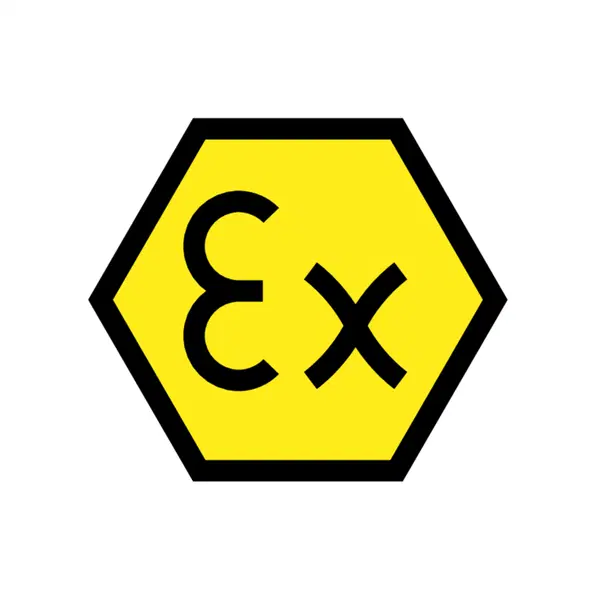Explosion is the worst accident that can easily threaten any kind of construction, residential and industrial space. Today, the use of gas or gasoline equipment has become common. Meanwhile, our surroundings are full of electronic equipment. A combination that is prone to explosion with the smallest technical problem. But in order to avoid this kind of accidents, all kinds of anti-explosion equipments have been designed and produced.
Anti-explosion equipment is not very efficient at home and construction level. Unless we face very special conditions. However, the use of anti-explosion equipment in industrial spaces and refinery processes, especially in oil and gas industries, is very common and important. Because in these industrial spaces we are supposed to work with a significant volume of explosive fluids. Continue with us to answer the question of what is explosion-proof equipment and what are the types of explosion-proof equipment?
What is explosion Where should explosion-proof equipment be used?proof equipment?

Any type of equipment that is protected against the penetration of dust, water and flammable liquids is known as explosion-proof equipment. The body of explosion-proof equipment is insulated against any type of electric current. For this reason, there is no possibility of sparks penetrating from inside this equipment.
Anti-explosion equipment are generally electrical tools that can be installed in industrial and explosion-prone places. In high-risk environments such as refinery spaces or oil and gas industries, mines, gas stations, CNG platforms, etc., the possibility of the spread of flammable gases and liquids is very high.
Anti-explosion equipment is designed in such a way that there is no possibility of leakage of electric current from them. Also, any type of fluid, dust and gas penetration into the interior of this equipment has been prevented. By using anti-explosion equipment in industrial environments, the possibility of explosion and fire is zero.
Where should explosion-proof equipment be used?
Anti-explosion equipment is used in places and areas that are flammable due to the presence of gases, vapors, dust, fibers and other things.
- Petrochemical and nuclear plants
- Refineries and mines
- Oil and gas tanks
- Oil rigs
- Gas stations and CNG stations
- Labs for manufacturing medicinal alcohols
- Laboratories working with chemicals, especially alcohol production
- Paper and paint warehouses
- Work houses and many industrial environments
- Chemical factories
The use of anti-explosion equipment is very wide and we need the presence of these equipments with different degrees of protection in almost every industrial and workshop environment and even construction. Therefore, they have categorized dangerous environments in a comprehensive discussion. In this way, we can fully consciously categorize the use cases of anti-explosion equipment in danger zones and gas groups. Buying anti-explosion equipment is common in all types of upstream industries. In the following, we will examine the classification of dangerous areas.
Classification of dangerous areas

If you look at the anti-explosion equipment, you will see words such as ZONE 1, ZONE 2, or EXD, EXP, etc. These writings or information actually represent the classification of dangerous areas. By using this information and knowing them, the technical capabilities of installing equipment in dangerous environments can be checked.
There are different standards for the classification of dangerous areas, the most famous and most reliable of which is Article 500 of the National Electrical Code of the United States of America (N.E.C). According to this standard, dangerous areas are classified into the following three classes, each of which has two parts:
- CLASS 1: Places where flammable gases or vapors are used or there is a possibility of flammable vapors and gases leaking.
- CLASS 2: Places where flammable dust such as grain dust, coal, some metals, etc. exist or may be created.
- CLASS 3: Places where flammable fibers and threads are used or may be created.
As mentioned, according to the American N.E.C regulations, each class is divided into two parts:
- Divison 1: There is a possibility of flammable gases and dusts in normal conditions.
- Divison 2: Only in abnormal conditions may flammable gases or dusts be formed.
The classification method of hazardous areas containing gases
| ZONE | RISK LEVEL | EXPLANATION |
|---|---|---|
| ZONE0 | very high | In this area, there is a mixture of flammable gases and air more than 1000 hours per year (on a sustained basis). |
| ZONE1 | medium | In this area, flammable gases are present between 10 and 1000 hours per year under normal conditions. |
| ZONE2 | Low | In this area, there is a mixture of flammable gases less than 10 hours a year and with a low probability of gas leakage. |
Method of classifying hazardous areas containing flammable dust:
| ZONE | RISK LEVEL | EXPLANATION |
|---|---|---|
| ZONE20 | very high | In this area, flammable dusts exist permanently or most of the time. |
| ZONE21 | medium | In this area, there are small amounts of flammable dust under normal conditions, which can cause fire and explosion. |
| ZONE22 | Low | In this area, inflammable dusts are very few and rarely present or in a very short period of time. |
Anti-explosion equipment in the classification of gas groups
Anti-explosion equipment is also designed to deal with these flammable gases in two categories:
- Group |: explosion-proof electrical equipment suitable for use in mines.
- Group||: Explosion-proof electrical equipment suitable for use in other hazardous areas.
Group || It is also divided into three categories A.B.C.:
- A||: Suitable for use in places prone to the penetration of dangerous gases such as ethane, methane, ammonia, etc. It is a group of gases with a high degree of ignition (with a minimum ignition energy of 190 microjoules).
- B||: This category includes common city gases, ethylene, etc., it should be noted that the ignition energy of these gases is lower than group 11A and they are far more dangerous.
- C||: This group of gases ignites with 20 microjoules and is considered one of the most dangerous gases that threatens human life at any moment. These gases ignite at a very high speed and with the slightest stimulation. Explosion-proof equipment manufactured in Class 11C can fully cover Class 11B or 11A gases.
Types of anti-explosion protection in electrical equipment
Explosion-proof electrical equipment is introduced with the EX symbol. When you see the word EX on the technical specification plate of any electrical equipment, you can rest assured about its anti-explosion capabilities. But different classes are designed for this purpose. The term EX is introduced along with other specifications. The type of protection is effective in the price of anti-explosion equipment. For optimal use and purchase of electrical explosion-proof equipment, you must have detailed information on the types of EX protection.
- EXD anti-explosion equipment: these equipment can withstand the explosion of flammable gases or vapors without igniting or damaging the surrounding environment.
- EXP anti-explosion equipment: These are anti-explosion equipment whose air inside the chamber has been emptied or filled with neutral gases. In this way, any kind of spark and electrical connection cannot leak out of the chamber.
- EXe anti-explosion equipment: This type of protection has a double degree of safety, such as thermal stability and preventing the spread of sparks. The EXe protection level is designed and created to prevent leakage of electric arc current. The housing of these explosion-proof equipment is often made of stainless steel or GRP material.
- EXDE anti-explosion equipment: There are equipment in which the spark-generating and non-sparking parts are separated. Sparking parts are placed in class d explosion-proof enclosure and non-sparking equipment is placed in class e enclosure. The whole set creates an EXDE class explosion-proof electrical unit.
- Ex i: Inherent safety
- Ex p: Protection related to pressurized containers
- Ex q: Protection related to powder filled equipment
- Ex o: Protection of equipment through immersion in non-flammable liquids
- Ex nA: Protection related to spark-ignition equipment
- Ex nC: Protection related to enclosed sparking equipment
- Ex nR: protection related to the confined space to prevent the entry of flammable gases and vapors
- Ex m: Equipment protection by encapsulation
- Ex t: Equipment protected against flammable dust
Valid standards for explosion-proof equipment in the world:
- European explosion-proof directives (ATEX standard)
- Non-explosive regulations in the United States and Canada (NEC)
- European explosion-proof equipment standard (IEC)
- EN standard
Introducing various types of anti-explosion equipment
- Explosion-proof enclosures
- Explosion-proof fittings
- Explosion-proof lighting
- Types of explosion-proof keys
- Explosion-proof ventilation
- Types of anti-explosion warning equipment
Explosion-proof boxes
Explosion-proof boxes consist of various electrical components such as terminal blocks, switches, relays, transformers and other arcing and ignition devices. Explosion-proof boxes are a type of explosion-proof enclosure that is resistant to corrosion and withstand They are high in extreme temperatures. These explosion-proof boxes prevent electric shocks, sparks, explosions, and disturbances in connections and internal parts.
Anti-explosion enclosures are one of the most useful equipments in the design of dangerous spaces prone to industrial explosions. These enclosures are made of stainless steel, aluminum or GRP and are generally light weight and designed in various shapes. Explosion-proof enclosures do not have electrical parts. Rather, they are supposed to protect one or a set of electrical equipment against an atmosphere prone to gases.
Types of explosion-proof enclosures:
- Explosion-proof distribution box
- Explosion-proof panel
- Explosion-proof terminal box
- Explosion-proof junction box
- Explosion-proof terminal box
Explosion proof lamp
All places need lighting, and this is also the case in industrial places, and of course it should be noted that we cannot use ordinary lights in high-risk industrial places. because it increases the possibility of explosion; Therefore, it is better to use explosion-proof lights, explosion-proof moonlights, etc. in these environments.
All kinds of anti-explosion lights are designed in different categories. These lights are made to illuminate dangerous spaces. Due to the fact that electric current is present in these lights, the possibility of sparks and ignition by them is very low even in the most dangerous spaces.
All kinds of explosion-proof lights:
- Explosion-proof moonshine
- Explosion-proof pendant light
- Explosion-proof projector
- Explosion-proof flashlight
- Explosion-proof tunnel light
- Explosion-proof hand light
- Anti-explosion signal light
- Explosion proof exit light
- And…
Explosion-proof fittings
Fittings are one of the most important anti-explosion equipments that are used for insulation or complete sealing of electrical equipment enclosures. Any type of electrical cable entering the electrical equipment compartment or exiting the enclosures is sealed using these connections.
The input and output of cables and wires are sealed by connections such as explosion-proof glands or explosion-proof caps to prevent the accumulation of dust in explosion-proof chambers. Explosion-proof connections prevent damage to the cable and wire coating.
Types of explosion-proof fittings:
- Explosion-proof glands
- Explosion-proof caps
- Explosion proof conversions
- Explosion-proof flexibles
Explosion-proof keys
Explosion-proof switches are used to disconnect and connect the electric current. Every industrial switchboard needs a key to start. Meanwhile, these keys should be designed with the specialized capabilities of anti-explosion equipment.
Anti-explosion switches are designed in single-phase and three-phase models with industrial dimensions and are available in 16, 25 and 32 amp models and even higher. These switches prevent spark leakage in gas and hazardous environments during disconnection and connection of current and prevent explosion and fire.
Types of explosion-proof keys:
- Explosion-proof sockets
- Explosion-proof socket box
- Explosion-proof limit switch
- Explosion-proof push button
Anti-explosion warning equipment
Anti-explosion warning equipment is one of the equipment that is used in most factories and industrial places.Warning equipment includes all kinds of alarms, sirens, etc. These equipments work using electrical signals, but their electrical current must not be prone to sparking in hazardous environments.
Types of anti-explosion warning equipment:
- Anti-explosion alarm
- Anti-explosion flasher
- Anti-explosion warning lights
- Explosion-proof mast light
Explosion-proof ventilation
Anti-explosion ventilation should be used in places where there are chemical and dangerous compounds. Anti-explosion ventilation transports all dangerous substances out of the environment and protects the health of the employees of that place.
It is necessary to install ventilation systems in dangerous environments prone to gas leaks. Because we must somehow be able to remove the gas that has leaked into the environment. Of course, both ventilation systems installed in such spaces must meet the design standards of explosion-proof equipment.
- Anti-explosion fans
- Explosion-proof coolers
Production standards of anti-explosion equipment

Any type of explosion-proof equipment must be designed in accordance with the EX grade standard. To standardize the design of explosion-proof equipment, tests have been designed that must be paid attention to before buying explosion-proof equipment.
Valid anti-explosion standards:
- European explosion-proof directives (ATEX standard)
- Non-explosive regulations in the United States and Canada (NEC)
- European explosion-proof equipment standard (IEC)
- EN standard
Any equipment must pass the following tests in order to receive certificates and anti-explosion standards:
- Explosion chamber tests
- Impact resistance tests
- Testing protection against penetration of objects, particles and dangerous liquids that can explode and fire (IP)
- Thermal and humidity stability tests
- Testing stability and resistance to cold
- UV stability test
It is mandatory to use anti-explosion equipment in high-risk industrial environments that are prone to explosion. In this article, what is the anti-explosion equipment? What is its use and what are the types of anti-explosion equipment?
We hope this article is useful for you.
